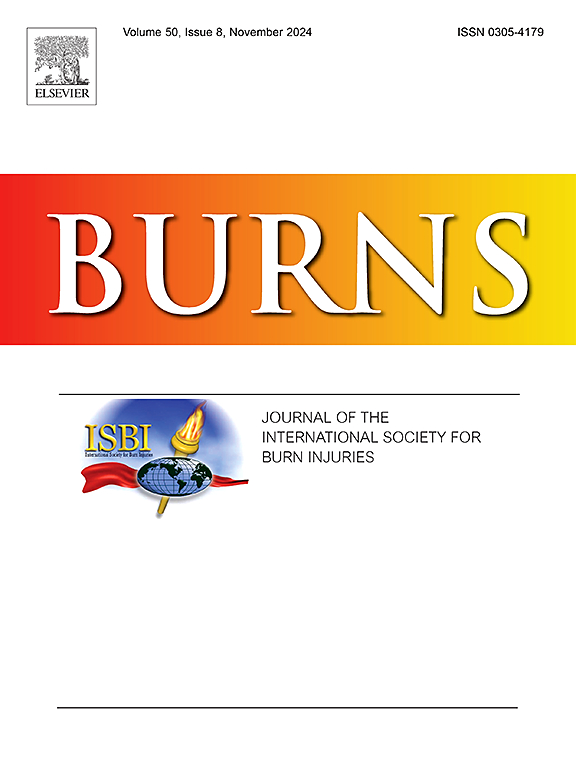Trichostatin A reverses rocuronium resistance in burn-injured rats
IF 3.2
3区 医学
Q2 CRITICAL CARE MEDICINE
引用次数: 0
Abstract
Aims
This study aimed to investigate whether the histone deacetylase HDAC4 inhibitor, trichostatin A (TSA), could reverse resistance to non-depolarizing muscle relaxants (NDMRs) caused by burn injuries.
Materials and methods
A rat burn injury model was established, in which TSA was administered to inhibit HDAC4 expression. The potency of rocuronium was assessed through tension tests, and the levels of HDAC4 and myogenin proteins were determined using Western blot. Additionally, siRNA was utilized to explore the effects of HDAC4 knockdown on rocuronium potency and protein expression.
Results
The burn injuries increased the IC50 of rocuronium, which was reversed by TSA treatment. Furthermore, HDAC4 and myogenin protein expression levels were increased significantly in burned legs, a phenomenon that TSA effectively counteracted. HDAC4 knockdown decreased rocuronium IC50 and lowered HDAC4 and myogenin protein expression in the subsequent burn injuries.
Conclusion
The HDAC4 inhibitor TSA has the ability to mitigate NDMR resistance in skeletal muscle via the HDAC4-myogenin pathway after burn injuries.
曲古抑素A逆转烧伤大鼠罗库溴铵耐药性。
目的:本研究旨在探讨组蛋白去乙酰化酶HDAC4抑制剂曲古抑素A (trichostatin A, TSA)是否能逆转烧伤对非去极化肌肉松弛剂(NDMRs)的耐药性。材料和方法:建立大鼠烧伤模型,给予TSA抑制HDAC4的表达。通过张力试验评估罗库溴铵的效价,并采用Western blot检测HDAC4和肌原蛋白的水平。此外,利用siRNA研究HDAC4敲低对罗库溴铵效价和蛋白表达的影响。结果:烧伤后罗库溴铵的IC50值升高,经TSA处理后IC50值逆转。此外,HDAC4和肌原蛋白表达水平在烧伤腿部显著升高,TSA有效地抵消了这一现象。在随后的烧伤中,HDAC4敲低可降低罗库溴铵IC50,降低HDAC4和肌原蛋白的表达。结论:HDAC4抑制剂TSA可通过HDAC4-myogenin通路减轻烧伤后骨骼肌NDMR耐药。
本文章由计算机程序翻译,如有差异,请以英文原文为准。
求助全文
约1分钟内获得全文
求助全文
来源期刊

Burns
医学-皮肤病学
CiteScore
4.50
自引率
18.50%
发文量
304
审稿时长
72 days
期刊介绍:
Burns aims to foster the exchange of information among all engaged in preventing and treating the effects of burns. The journal focuses on clinical, scientific and social aspects of these injuries and covers the prevention of the injury, the epidemiology of such injuries and all aspects of treatment including development of new techniques and technologies and verification of existing ones. Regular features include clinical and scientific papers, state of the art reviews and descriptions of burn-care in practice.
Topics covered by Burns include: the effects of smoke on man and animals, their tissues and cells; the responses to and treatment of patients and animals with chemical injuries to the skin; the biological and clinical effects of cold injuries; surgical techniques which are, or may be relevant to the treatment of burned patients during the acute or reconstructive phase following injury; well controlled laboratory studies of the effectiveness of anti-microbial agents on infection and new materials on scarring and healing; inflammatory responses to injury, effectiveness of related agents and other compounds used to modify the physiological and cellular responses to the injury; experimental studies of burns and the outcome of burn wound healing; regenerative medicine concerning the skin.
 求助内容:
求助内容: 应助结果提醒方式:
应助结果提醒方式:


